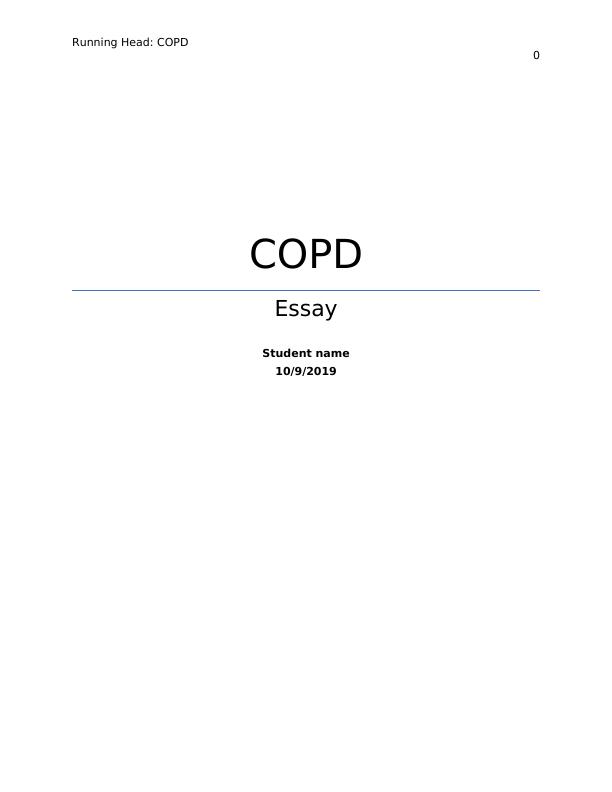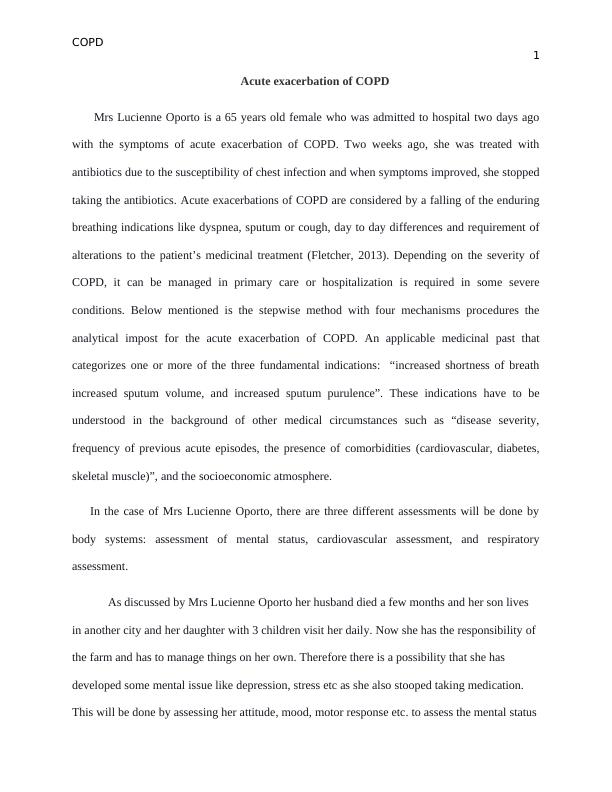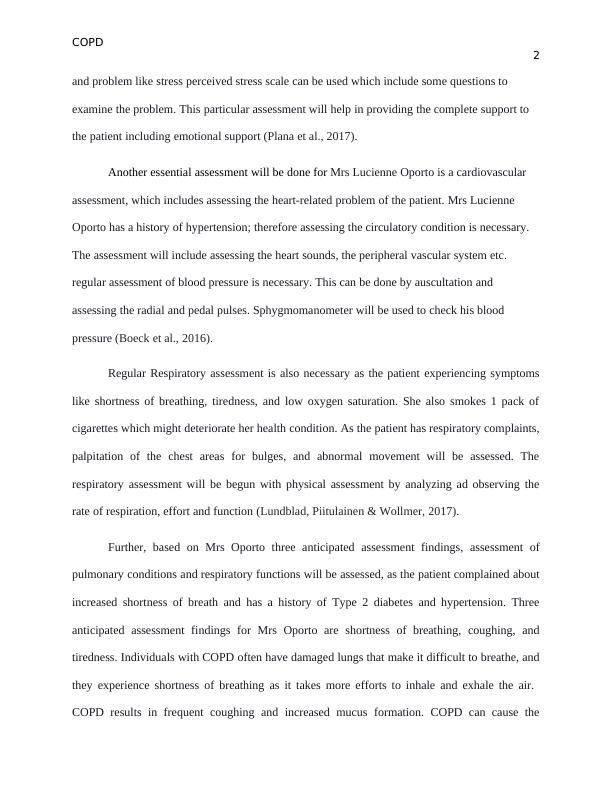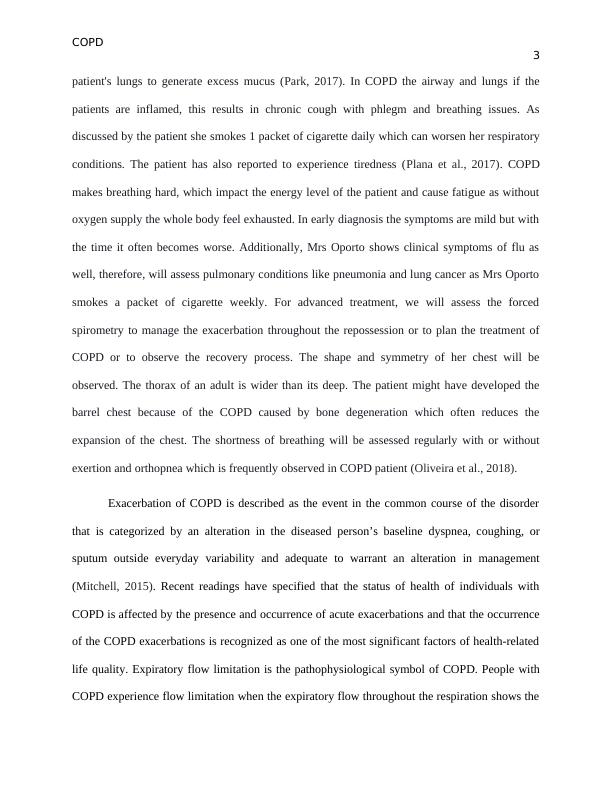Acute Exacerbation of COPD: Assessment, Diagnosis and Management
Added on 2022-10-06
11 Pages3243 Words257 Views
Running Head: COPD
0
COPD
Essay
Student name
10/9/2019
0
COPD
Essay
Student name
10/9/2019

COPD
1
Acute exacerbation of COPD
Mrs Lucienne Oporto is a 65 years old female who was admitted to hospital two days ago
with the symptoms of acute exacerbation of COPD. Two weeks ago, she was treated with
antibiotics due to the susceptibility of chest infection and when symptoms improved, she stopped
taking the antibiotics. Acute exacerbations of COPD are considered by a falling of the enduring
breathing indications like dyspnea, sputum or cough, day to day differences and requirement of
alterations to the patient’s medicinal treatment (Fletcher, 2013). Depending on the severity of
COPD, it can be managed in primary care or hospitalization is required in some severe
conditions. Below mentioned is the stepwise method with four mechanisms procedures the
analytical impost for the acute exacerbation of COPD. An applicable medicinal past that
categorizes one or more of the three fundamental indications: “increased shortness of breath
increased sputum volume, and increased sputum purulence”. These indications have to be
understood in the background of other medical circumstances such as “disease severity,
frequency of previous acute episodes, the presence of comorbidities (cardiovascular, diabetes,
skeletal muscle)”, and the socioeconomic atmosphere.
In the case of Mrs Lucienne Oporto, there are three different assessments will be done by
body systems: assessment of mental status, cardiovascular assessment, and respiratory
assessment.
As discussed by Mrs Lucienne Oporto her husband died a few months and her son lives
in another city and her daughter with 3 children visit her daily. Now she has the responsibility of
the farm and has to manage things on her own. Therefore there is a possibility that she has
developed some mental issue like depression, stress etc as she also stooped taking medication.
This will be done by assessing her attitude, mood, motor response etc. to assess the mental status
1
Acute exacerbation of COPD
Mrs Lucienne Oporto is a 65 years old female who was admitted to hospital two days ago
with the symptoms of acute exacerbation of COPD. Two weeks ago, she was treated with
antibiotics due to the susceptibility of chest infection and when symptoms improved, she stopped
taking the antibiotics. Acute exacerbations of COPD are considered by a falling of the enduring
breathing indications like dyspnea, sputum or cough, day to day differences and requirement of
alterations to the patient’s medicinal treatment (Fletcher, 2013). Depending on the severity of
COPD, it can be managed in primary care or hospitalization is required in some severe
conditions. Below mentioned is the stepwise method with four mechanisms procedures the
analytical impost for the acute exacerbation of COPD. An applicable medicinal past that
categorizes one or more of the three fundamental indications: “increased shortness of breath
increased sputum volume, and increased sputum purulence”. These indications have to be
understood in the background of other medical circumstances such as “disease severity,
frequency of previous acute episodes, the presence of comorbidities (cardiovascular, diabetes,
skeletal muscle)”, and the socioeconomic atmosphere.
In the case of Mrs Lucienne Oporto, there are three different assessments will be done by
body systems: assessment of mental status, cardiovascular assessment, and respiratory
assessment.
As discussed by Mrs Lucienne Oporto her husband died a few months and her son lives
in another city and her daughter with 3 children visit her daily. Now she has the responsibility of
the farm and has to manage things on her own. Therefore there is a possibility that she has
developed some mental issue like depression, stress etc as she also stooped taking medication.
This will be done by assessing her attitude, mood, motor response etc. to assess the mental status

COPD
2
and problem like stress perceived stress scale can be used which include some questions to
examine the problem. This particular assessment will help in providing the complete support to
the patient including emotional support (Plana et al., 2017).
Another essential assessment will be done for Mrs Lucienne Oporto is a cardiovascular
assessment, which includes assessing the heart-related problem of the patient. Mrs Lucienne
Oporto has a history of hypertension; therefore assessing the circulatory condition is necessary.
The assessment will include assessing the heart sounds, the peripheral vascular system etc.
regular assessment of blood pressure is necessary. This can be done by auscultation and
assessing the radial and pedal pulses. Sphygmomanometer will be used to check his blood
pressure (Boeck et al., 2016).
Regular Respiratory assessment is also necessary as the patient experiencing symptoms
like shortness of breathing, tiredness, and low oxygen saturation. She also smokes 1 pack of
cigarettes which might deteriorate her health condition. As the patient has respiratory complaints,
palpitation of the chest areas for bulges, and abnormal movement will be assessed. The
respiratory assessment will be begun with physical assessment by analyzing ad observing the
rate of respiration, effort and function (Lundblad, Piitulainen & Wollmer, 2017).
Further, based on Mrs Oporto three anticipated assessment findings, assessment of
pulmonary conditions and respiratory functions will be assessed, as the patient complained about
increased shortness of breath and has a history of Type 2 diabetes and hypertension. Three
anticipated assessment findings for Mrs Oporto are shortness of breathing, coughing, and
tiredness. Individuals with COPD often have damaged lungs that make it difficult to breathe, and
they experience shortness of breathing as it takes more efforts to inhale and exhale the air.
COPD results in frequent coughing and increased mucus formation. COPD can cause the
2
and problem like stress perceived stress scale can be used which include some questions to
examine the problem. This particular assessment will help in providing the complete support to
the patient including emotional support (Plana et al., 2017).
Another essential assessment will be done for Mrs Lucienne Oporto is a cardiovascular
assessment, which includes assessing the heart-related problem of the patient. Mrs Lucienne
Oporto has a history of hypertension; therefore assessing the circulatory condition is necessary.
The assessment will include assessing the heart sounds, the peripheral vascular system etc.
regular assessment of blood pressure is necessary. This can be done by auscultation and
assessing the radial and pedal pulses. Sphygmomanometer will be used to check his blood
pressure (Boeck et al., 2016).
Regular Respiratory assessment is also necessary as the patient experiencing symptoms
like shortness of breathing, tiredness, and low oxygen saturation. She also smokes 1 pack of
cigarettes which might deteriorate her health condition. As the patient has respiratory complaints,
palpitation of the chest areas for bulges, and abnormal movement will be assessed. The
respiratory assessment will be begun with physical assessment by analyzing ad observing the
rate of respiration, effort and function (Lundblad, Piitulainen & Wollmer, 2017).
Further, based on Mrs Oporto three anticipated assessment findings, assessment of
pulmonary conditions and respiratory functions will be assessed, as the patient complained about
increased shortness of breath and has a history of Type 2 diabetes and hypertension. Three
anticipated assessment findings for Mrs Oporto are shortness of breathing, coughing, and
tiredness. Individuals with COPD often have damaged lungs that make it difficult to breathe, and
they experience shortness of breathing as it takes more efforts to inhale and exhale the air.
COPD results in frequent coughing and increased mucus formation. COPD can cause the

COPD
3
patient's lungs to generate excess mucus (Park, 2017). In COPD the airway and lungs if the
patients are inflamed, this results in chronic cough with phlegm and breathing issues. As
discussed by the patient she smokes 1 packet of cigarette daily which can worsen her respiratory
conditions. The patient has also reported to experience tiredness (Plana et al., 2017). COPD
makes breathing hard, which impact the energy level of the patient and cause fatigue as without
oxygen supply the whole body feel exhausted. In early diagnosis the symptoms are mild but with
the time it often becomes worse. Additionally, Mrs Oporto shows clinical symptoms of flu as
well, therefore, will assess pulmonary conditions like pneumonia and lung cancer as Mrs Oporto
smokes a packet of cigarette weekly. For advanced treatment, we will assess the forced
spirometry to manage the exacerbation throughout the repossession or to plan the treatment of
COPD or to observe the recovery process. The shape and symmetry of her chest will be
observed. The thorax of an adult is wider than its deep. The patient might have developed the
barrel chest because of the COPD caused by bone degeneration which often reduces the
expansion of the chest. The shortness of breathing will be assessed regularly with or without
exertion and orthopnea which is frequently observed in COPD patient (Oliveira et al., 2018).
Exacerbation of COPD is described as the event in the common course of the disorder
that is categorized by an alteration in the diseased person’s baseline dyspnea, coughing, or
sputum outside everyday variability and adequate to warrant an alteration in management
(Mitchell, 2015). Recent readings have specified that the status of health of individuals with
COPD is affected by the presence and occurrence of acute exacerbations and that the occurrence
of the COPD exacerbations is recognized as one of the most significant factors of health-related
life quality. Expiratory flow limitation is the pathophysiological symbol of COPD. People with
COPD experience flow limitation when the expiratory flow throughout the respiration shows the
3
patient's lungs to generate excess mucus (Park, 2017). In COPD the airway and lungs if the
patients are inflamed, this results in chronic cough with phlegm and breathing issues. As
discussed by the patient she smokes 1 packet of cigarette daily which can worsen her respiratory
conditions. The patient has also reported to experience tiredness (Plana et al., 2017). COPD
makes breathing hard, which impact the energy level of the patient and cause fatigue as without
oxygen supply the whole body feel exhausted. In early diagnosis the symptoms are mild but with
the time it often becomes worse. Additionally, Mrs Oporto shows clinical symptoms of flu as
well, therefore, will assess pulmonary conditions like pneumonia and lung cancer as Mrs Oporto
smokes a packet of cigarette weekly. For advanced treatment, we will assess the forced
spirometry to manage the exacerbation throughout the repossession or to plan the treatment of
COPD or to observe the recovery process. The shape and symmetry of her chest will be
observed. The thorax of an adult is wider than its deep. The patient might have developed the
barrel chest because of the COPD caused by bone degeneration which often reduces the
expansion of the chest. The shortness of breathing will be assessed regularly with or without
exertion and orthopnea which is frequently observed in COPD patient (Oliveira et al., 2018).
Exacerbation of COPD is described as the event in the common course of the disorder
that is categorized by an alteration in the diseased person’s baseline dyspnea, coughing, or
sputum outside everyday variability and adequate to warrant an alteration in management
(Mitchell, 2015). Recent readings have specified that the status of health of individuals with
COPD is affected by the presence and occurrence of acute exacerbations and that the occurrence
of the COPD exacerbations is recognized as one of the most significant factors of health-related
life quality. Expiratory flow limitation is the pathophysiological symbol of COPD. People with
COPD experience flow limitation when the expiratory flow throughout the respiration shows the

End of preview
Want to access all the pages? Upload your documents or become a member.
Related Documents
Case Scenario of an Older Patient.lg...
|17
|4367
|24
Nursing Case Study on Sepsis: Pathophysiology, Assessment, and Managementlg...
|14
|3573
|231
Case Study : 60-year-old Female Presenting With Shortness of Breathlg...
|10
|3937
|24
Palliative Care: Strategies for COPD Exacerbation Managementlg...
|6
|1682
|50
abrupt exacerbation of COPDlg...
|7
|1931
|110
Nursing Case Study on Clinical Manifestations, Interventions, and Health Promotion for Mrs. Jlg...
|7
|1618
|161
